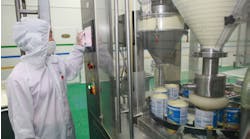IN THE PIPELINE
Figure 1. Flame propagation research is providing insights for improved passive isolation solutions. Source: Fike.
Dealing with dust is a serious matter — and one recent court case has given it a new dimension.Last November, Craig Sanborn, owner of a munitions plant in Lancaster, N.H., was sentenced to 10 to 20 years in prison after his conviction for manslaughter. This followed the death of two workers in a November 2010 dust-related blast at the plant. Prosecutors say he was reckless in manufacturing, testing and storing gun powder, and failed to adequately train the two workers who died."To my knowledge, this is the first time ever in the U.S. that a criminal conviction has followed a dust explosion," says Bob Korn, Director of Sales and Marketing, Industrial Protection Group,
Fike Corporation, Blue Springs, Mo.At the same time as the authorities seem to be toughening their stance with regard to such incidents, Korn has noticed a change in the types of queries coming from the chemical industry. Two or three years ago, such queries typically concerned equipment applications, code compliance issues and hazard assessment. Anticipated timelines for OSHA standards, the operating costs of inert atmospheres compared with the capital costs of suppression or flame-arrest systems, and determination of particle size and shape all were keeping the industry exercised. "The industry in general and its people are more educated about the hazards associated with dust now. So the questions today tend to come from the perspective of 'I understand I need explosion protection, but what are the options for these particular applications?,'" he says.Publication of the standard OSHA currently has under development should provide some clarifications. However, it's still mired in the final stages of the long rule-making process. "I would love to see something by the end of the year and this administration does have the opportunity to push it out. However, it will be politically unpopular because companies will be forced to spend money to implement it, so I expect a lot of pushback from lobby groups," Korn comments.Meanwhile, the European Union (EU) in December 2013 issued the latest update to its ATEX regulations for protecting employees from explosion risk in areas with an explosive atmosphere. "Since ATEX came into force [in 2003], companies in Europe came under a legal mandate to protect their facilities. So there is greater demand in Europe versus the rest of the world for our explosion protection equipment," notes Korn. The European Commission now aims to harmonize the laws of the member states to establish a common framework for the marketing of equipment and protective systems intended for use in potentially explosive atmospheres. The proposal currently is under discussion; approval of the new aligned ATEX Directive is expected during the course of 2014.
NEW THRUSTSFor its part, Fike is focusing strongly on new technologies and expanding into new markets. First up is the EP Control System. Slated for introduction this year, its entirely new design will provide state-of-the-art control for the explosion protection systems used by Fike customers. "A newer focus is on more passive isolation solutions. In the U.S. particularly, there tends to be a stepped approach to this from customers. Step one is do nothing. Step two is to use a passive explosion venting system. Step three is for the full active explosion protection system with an electronic control system. So we are focusing on step two at the moment and this will involve launching a new passive isolation solution later this year," notes Korn, who is reluctant to divulge details just yet.In a big move, the company also is looking at expanding into the explosion prevention market. For example, Fike is developing dust detection equipment that can spot changes in dust concentration levels in pipelines. It also is actively working on custom solutions to challenge more traditional prevention methods currently in use. Again, details are guarded at the moment. "Our approach is that we don't want to be a 'me too' player. So we look for more technologically advanced solutions that require a greater understanding of the event phenomena and that can be integrated with our existing expertise," says Korn. Better passive isolation solutions are an example. Here, the company has been conducting flame propagation research for the last two years to increase its understanding of the interrelationships between vented vessels, Kst (dust explosibility), dust loading, conveyance velocities and other factors that affect how it goes about designing specific customer solutions (
Figure 1). Explosion isolation is very important because flame propagation in a duct or pipe can lead to a secondary explosion — and this usually causes the most devastating consequences. "Through our research we have been able to validate the performance of our passive isolation solution and have learned much more about the factors that influence flame propagation. This information is beginning to be shared through industry-related conferences and papers," adds Korn.To this end, the company is making substantial investments in its remote explosion testing facility, doubling its physical size while adding many new capabilities. The enhancements will boost Fike's ability to carry out live explosion testing for OEM partners that are working to make their equipment designs safer.
DUST-FREE DISCHARGEMinimizing the amount of dust generated is a challenge at many sites. Discharge of material from a hopper often can create a substantial amount of dust. To combat this problem, Dust Suppression Hopper (DSH) Systems, Auckland, New Zealand, has designed a novel loading spout that contains dust within the product stream. The company says its DSH technology avoids the need for the more-complicated systems currently used in applications involving bulk dry, granular, free-flowing products, such as fertilizers, sugars, some limes and salt. The standard models require no utilities and have no internal moving parts, while the programmable feed control system automatically configures the hopper for variable product weights.The DSH system is installed under a feed point. It concentrates the discharge of dry goods as a solid column through free air into any target repository including trucks, railcars, barges, stockpiles, storage containers or bags.The technology proved itself during a 2013 trial at a facility in New South Wales, Australia, loading trucks with a variety of products, including three fertilizers. Initially, loading the fertilizers into the trucks took more time than with the original loading chute. However, modification of the hopper spout enabled achieving the same speed as with the traditional unit — but with what the company describes at "massive" dust reductions.


